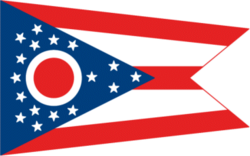Ohio (U.S. state): Difference between revisions
imported>Todd Coles No edit summary |
imported>Larry Sanger No edit summary |
||
| Line 1: | Line 1: | ||
{{subpages}} | {{subpages}} | ||
[[Image:Ohio flag.png|right|thumb|250px|{{#ifexist:Template:Ohio flag.png/credit|{{Ohio flag.png/credit}}<br/>|}}State Flag of Ohio. Ohio is the only US State with a non-rectangular flag.]] | [[Image:Ohio flag.png|right|thumb|250px|{{#ifexist:Template:Ohio flag.png/credit|{{Ohio flag.png/credit}}<br/>|}}State Flag of Ohio. Ohio is the only US State with a non-rectangular flag.]] | ||
'''Ohio''', nicknamed the Buckeye State, was the 17th state admitted to the [[United States of America]] on March 1, 1803. Ohio is the | '''Ohio''', nicknamed the Buckeye State, was the 17th state admitted to the [[United States of America]] on March 1, 1803. Ohio is the seventh most populous state in the United States, with a population estimated at 11,478,006 people,<ref>2006 estimate. [http://quickfacts.census.gov/qfd/states/39000.html State and County Quickfacts,] U.S. Census Bureau. Data derived from Population Estimates, Census of Population and Housing, Small Area Income and Poverty Estimates, State and County Housing Unit Estimates, County Business Patterns, Nonemployer Statistics, Economic Census, Survey of Business Owners, Building Permits, Consolidated Federal Funds Report.</ref> while ranking 34th in land area. | ||
Ohio holds the distinction of being the birthplace of more US Presidents than any other state with 8. | Ohio holds the distinction of being the birthplace of more US Presidents than any other state with 8. | ||
| Line 8: | Line 8: | ||
Ohio is located in the Midwest, bordered by [[Michigan]] and [[Lake Erie]] to the north, [[Indiana]] to the west, [[Kentucky]] and [[West Virginia]] to the south, and [[Pennsylvania]] to the east. The [[Ohio River]], a tributary of the [[Mississippi River]], is the largest river in the state and forms it's southern border. | Ohio is located in the Midwest, bordered by [[Michigan]] and [[Lake Erie]] to the north, [[Indiana]] to the west, [[Kentucky]] and [[West Virginia]] to the south, and [[Pennsylvania]] to the east. The [[Ohio River]], a tributary of the [[Mississippi River]], is the largest river in the state and forms it's southern border. | ||
The capital is [[Columbus, Ohio|Columbus]]. Other | The capital is [[Columbus, Ohio|Columbus]], which is also the most populous city in the state. However, the metropolitan areas of Cleveland and Cincinnati are bigger, each having over two million people. Other cities include [[Dayton, Ohio|Dayton]], [[Toledo, Ohio|Toledo]], [[Akron, Ohio|Akron]], [[Youngstown, Ohio|Youngstown]], and [[Canton, Ohio|Canton]]. | ||
Revision as of 09:13, 6 February 2008
Ohio, nicknamed the Buckeye State, was the 17th state admitted to the United States of America on March 1, 1803. Ohio is the seventh most populous state in the United States, with a population estimated at 11,478,006 people,[1] while ranking 34th in land area.
Ohio holds the distinction of being the birthplace of more US Presidents than any other state with 8.
Geography
Ohio is located in the Midwest, bordered by Michigan and Lake Erie to the north, Indiana to the west, Kentucky and West Virginia to the south, and Pennsylvania to the east. The Ohio River, a tributary of the Mississippi River, is the largest river in the state and forms it's southern border.
The capital is Columbus, which is also the most populous city in the state. However, the metropolitan areas of Cleveland and Cincinnati are bigger, each having over two million people. Other cities include Dayton, Toledo, Akron, Youngstown, and Canton.
- ↑ 2006 estimate. State and County Quickfacts, U.S. Census Bureau. Data derived from Population Estimates, Census of Population and Housing, Small Area Income and Poverty Estimates, State and County Housing Unit Estimates, County Business Patterns, Nonemployer Statistics, Economic Census, Survey of Business Owners, Building Permits, Consolidated Federal Funds Report.
